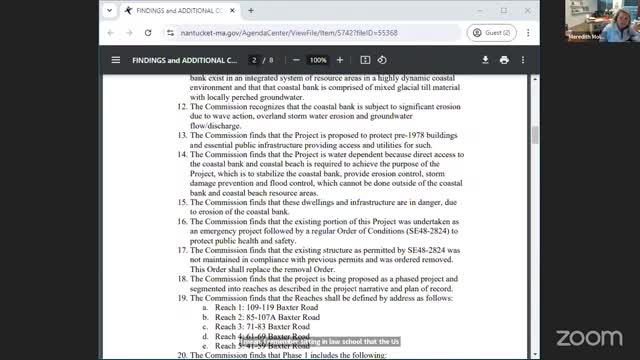Urgent debate on imminent danger to coastal homes
August 09, 2024 | Nantucket County, Massachusetts
This article was created by AI summarizing key points discussed. AI makes mistakes, so for full details and context, please refer to the video of the full meeting. Please report any errors so we can fix them. Report an error »

In a recent government meeting, officials engaged in a detailed discussion regarding the imminent danger posed to homes and infrastructure along Baxter Road due to coastal erosion. The meeting highlighted the need for clear definitions and regulations to address the risks associated with storm damage, particularly in light of recent severe weather events.
Key points of contention included the definition of \"imminent danger,\" with some officials advocating for a linear distance of 40 feet from the coastal bank to trigger protective measures, while others suggested a more complex evaluation based on the potential impact of consecutive storms. The debate underscored the urgency of establishing a regulatory framework that accurately reflects the realities of coastal erosion and storm risks.
Dr. Dunk, a prominent voice in the discussion, emphasized the importance of defining imminent danger based on scientifically grounded criteria rather than relying solely on historical storm data. He argued that the current regulatory language lacks clarity and fails to account for the variability of storm seasons, which complicates the assessment of risk.
The conversation also touched on the distinction between structures and infrastructure, with some officials expressing concern that focusing solely on homes could overlook the critical role of roads and utilities in emergency situations. The need for a cohesive approach that protects both dwellings and essential infrastructure was a recurring theme.
As the meeting progressed, the commission acknowledged the complexity of the issues at hand and agreed to seek further guidance from legal counsel regarding the protection of infrastructure under existing regulations. A motion was passed to request expert input on the matter, reflecting a commitment to ensuring that any decisions made are legally sound and in the best interest of public safety.
The meeting concluded with a consensus to revisit the definitions of imminent danger and the criteria for protective measures at the next session, highlighting the ongoing efforts to balance regulatory compliance with the pressing need for effective coastal management strategies.
Key points of contention included the definition of \"imminent danger,\" with some officials advocating for a linear distance of 40 feet from the coastal bank to trigger protective measures, while others suggested a more complex evaluation based on the potential impact of consecutive storms. The debate underscored the urgency of establishing a regulatory framework that accurately reflects the realities of coastal erosion and storm risks.
Dr. Dunk, a prominent voice in the discussion, emphasized the importance of defining imminent danger based on scientifically grounded criteria rather than relying solely on historical storm data. He argued that the current regulatory language lacks clarity and fails to account for the variability of storm seasons, which complicates the assessment of risk.
The conversation also touched on the distinction between structures and infrastructure, with some officials expressing concern that focusing solely on homes could overlook the critical role of roads and utilities in emergency situations. The need for a cohesive approach that protects both dwellings and essential infrastructure was a recurring theme.
As the meeting progressed, the commission acknowledged the complexity of the issues at hand and agreed to seek further guidance from legal counsel regarding the protection of infrastructure under existing regulations. A motion was passed to request expert input on the matter, reflecting a commitment to ensuring that any decisions made are legally sound and in the best interest of public safety.
The meeting concluded with a consensus to revisit the definitions of imminent danger and the criteria for protective measures at the next session, highlighting the ongoing efforts to balance regulatory compliance with the pressing need for effective coastal management strategies.
View full meeting
This article is based on a recent meeting—watch the full video and explore the complete transcript for deeper insights into the discussion.
View full meeting
